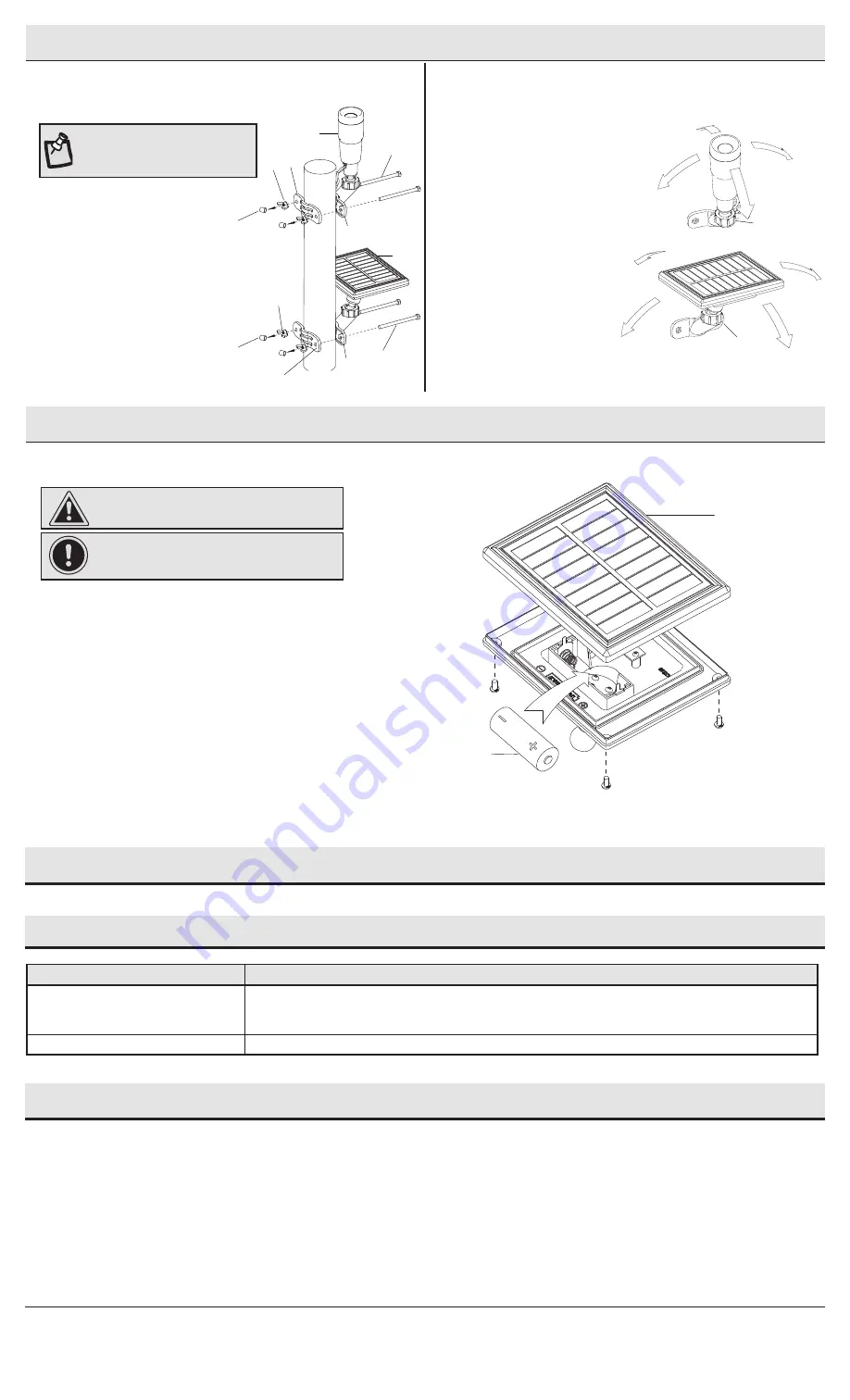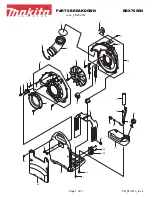
2
D1 or D2
D1 or D2
I
I
E
E
C
C
B
B
A
A
Maintenance
Care & Cleaning
Troubleshooting
Warranty
Replacing the battery
CAUTION
: When replacing the battery, use a 1100mAh
LiFePO4, 18500, 3.2V rechargeable battery.
IMPORTANT
: Dispose of the battery in accordance with
local, state, and federal regulations.
□
Open the battery cover (1) on the solar panel (A) by removing the four
screws with a screwdriver.
□
Replace the old battery with a fresh 1100mAh LiFePO4,18500, 3.2V
rechargeable battery.
□
Replace the battery cover (1) on the solar panel (A).
□
Clean the solar panel with a damp cloth. Do not use any chemicals or abrasives.
Problem
Solution
The nightly runtime for the lights is shorter.
□
The battery is not adequately charged. Locate the solar light in an area where it can receive the maximum amount
of full, direct sunlight every day.
□
The battery is reaching the end of its useful life. Replace the old battery with a new battery.
The lights do not turn on in the evening.
□
The solar panel is installed close to other light sources. Relocate the solar panel or eliminate the other light sources.
The manufacturer warrants this product to be free for two (2) years against any defects that are due to faulty materials or workmanship. This warranty applies only to the
original consumer purchaser and only to products used in normal use and service. If this product is found to be defective, the manufacturer’s only obligation, and your
exclusive remedy, is the repair or replacement of the product at the manufacturer’s discretion, provided that the product has not been damaged through misuse, abuse,
accident, modifications, alterations, neglect or mishandling. This warranty shall not apply to any product that is found to have been improperly installed, set up, or used
in any way not in accordance with the instructions supplied with the product. This warranty shall not apply to a failure of the product as a result of an accident, misuse,
abuse, negligence, alteration, or faulty installation or any other failure not relating to faulty workmanship. This warranty shall not apply to the finish on any portion of the
product, such as surface and/or weathering, as this is considered normal wear and tear. The manufacturer does not warrant and specifically disclaims any warranty,
whether expressed or implied, or fitness for a particular purpose, other than the warranty contained herein. The manufacturer specifically disclaims any liability and
shall not be liable for any consequential or incidental loss or damage, including any labor/expense costs involved in the replacement or repair of said product.
Contact the Customer Service Team at 1-855-HD-HAMPTON or visit hamptonbay.com.
Assembly and Installation (continued)
Charging the battery
□
For optimum performance, it is best to install the solar light in full sunlight
and let it charge for 10-12 hours.
□
Allow the light to run at least 8-12 entire charging and discharging cycles to
reach the maximum capacity of the battery.
Winter tips
□
Keep debris and snow off the solar panel to allow the battery to recharge. If lights have been covered by snow for a long time, allow the battery to recharge
in full, direct sunlight for at least 10-12 hours so it can maintain maximum capacity.
□
Mount the fixing bracket (B) of the
flag light (A) and the bracket (C)
against the post.
□
Install the bolts (D1 or D2) through
the fixing bracket (B) and the
bracket (C) and fasten the wing
nuts (E) on the bolts (D1 or D2),
twisting them clockwise until
tight.
□
Repeat the previous step to mount
the solar panel (B) to the post.
□
Add the rubber cap (I) to the end
of the bolt to prevent the flag from
tearing on it.
Installing the flag light on
a post (offset option)
2c
1
F
NOTE: There are two kinds of
bolts (D1, D2). Choose the correct
one according to the flag post
diameter.
compression
nut
compression
nut
Adjusting the flag light and solar panel
3
□
The light can be set in a
variety of positions to provide
focused light. To adjust
the light position, loosen
the compression nut at the
base of the light, adjust the
position and retighten the
compression nut.
□
The solar panel can be set
in a variety of positions to
allow for maximum sun
exposure. To adjust the
solar panel position, loosen
the compression nut at the
base of the panel, adjust the
position and retighten the
compression nut.






















